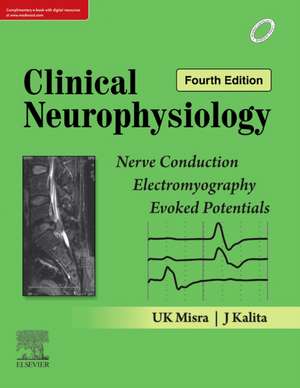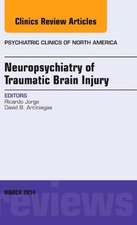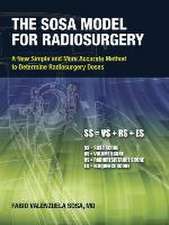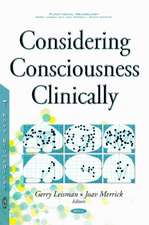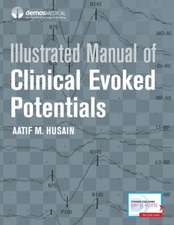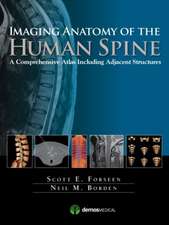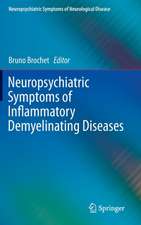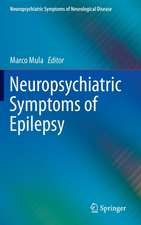Clinical Neurophysiology: Nerve Conduction, Electromyography, Evoked Potentials
Autor Usha Kant Misra, Jayantee Kalitaen Limba Engleză Hardback – 26 dec 2019
Clinical neurophysiology has evolved as an extension of clinical examination. This book has three main parts of electrodiagnosis - nerve conduction, electromyography and evoked potentials. The emphasis is on correct method of conducting the test including pitfalls, precautions, and proper interpretation of the results. The normal values of various tests have been provided. The application of nerve conduction, electromyography and evoked potentials in various neurological disorders has been discussed for bedside application and clinical problem solving.
Preț: 530.59 lei
Preț vechi: 585.04 lei
-9% Nou
Puncte Express: 796
Preț estimativ în valută:
101.54€ • 105.62$ • 83.83£
101.54€ • 105.62$ • 83.83£
Carte disponibilă
Livrare economică 17-31 martie
Preluare comenzi: 021 569.72.76
Specificații
ISBN-13: 9788131258156
ISBN-10: 8131258157
Pagini: 452
Ilustrații: 415 illustrations (415 in full color)
Ediția:4
Editura: Elsevier
ISBN-10: 8131258157
Pagini: 452
Ilustrații: 415 illustrations (415 in full color)
Ediția:4
Editura: Elsevier
Cuprins
1 History of Clinical Neurophysiology
Classic Electrodiagnosis
Electromyography and Nerve Stimulation
Technique
Evoked Potentials
Miscellaneous
2 An Introduction to Electrodiagnostic Signals and Their Measurements
Biophysics
Electrodes
Filter
Amplifi er
Averager
Display
Gain and Sweep Time
Signal Trigger and Delay Line
Stimulator
Referral Process
3 Nerve Conduction Study
3.1 PRINCIPLES OF NERVE CONDUCTION STUDY
Anatomy and Physiology
Axonal Transport
Impulse Propagation
Principles of Motor Nerve Conduction
Principles of Sensory Nerve Conduction
Variables Aff ecting the Nerve Conduction Study
3.2 MEDIAN NERVE
Anatomy
Nerve Conduction Study
Median Nerve Entrapment Syndromes
3.3 ULNAR NERVE
Anatomy
Nerve Conduction Study
Ulnar Neuropathy
3.4 RADIAL NERVE
Anatomy
Nerve Conduction Study
Radial Neuropathy
3.5 BRACHIAL PLEXUS
Anatomy
Brachial Plexopathy
Neurophysiological Assessment of Brachial Plexus Lesions
Thoracic Outlet Obstruction
Brachial Neuritis
Radiation-Induced Plexopathy
Obstetric Brachial Plexopathy
3.6 CERVICAL RADICULOPATHY
Anatomy
Motor and Sensory Nerve Conduction
F Wave
Somatosensory Evoked Potentials
Nerve Root Stimulation
Needle Electromyography
Cervical Radiculopathy
3.7 LUMBAR PLEXUS AND ITS TERMINAL BRANCHES
Anatomy
Lumbosacral Plexopathy
Neurophysiological Evaluation
3.8 SACRAL PLEXUS AND ITS TERMINAL NERVE BRANCHES
Anatomy
3.9 LUMBOSACRAL RADICULOPATHY
Anatomy
L2, L3, and L4 Radiculopathies
L5 Radiculopathy
S1 and S2 Radiculopathy
Multiple Lumbosacral Radiculopathies
Diagnostic Utility of EMG and MRI in Radiculopathy
3.10 ANOMALOUS INNERVATION OF THE EXTREMITIES
Median to Ulnar Nerve Communication (Martin-Gruber Anastomosis)
Ulnar to Median Nerve Communication
Variations in the Innervations of Intrinsic Hand Muscles
Accessory Deep Peroneal Nerve
Tibial and Peroneal Nerve Communication
3.11 NERVE CONDUCTION OF NONLIMB NERVES
Phrenic Nerve
Facial Nerve
Hypoglossal Nerve
Great Auricular Nerve
3.12 LATE RESPONSE
H Refl ex
F Wave
Axon Refl ex
3.13 AUTONOMIC NERVOUS SYSTEM TESTING
Anatomical and Functional Basis
Autonomic Function Tests
4 Electromyography
4.1 INTRODUCTION TO ELECTROMYOGRAPHY
Anatomy of Muscle
Types of EMG Needle Electrodes
Recording Technique
4.2 TECHNIQUE OF ELECTROMYOGRAPHY
Muscles of Hands
Muscles of Forearm
Muscles of Arm
Muscles of Shoulder Girdle and Trunk
Muscle of Foot
Muscles of Leg
Muscles of Thigh
Muscles of Pelvic Girdle
Muscles of Face, Head, and Neck
Video 4.1 Insertional activity
Video 4.2 Positive sharp waves and fi brillations
Video 4.3 Myotonic discharges
Video 4.4 Complex repetitive discharge (CRD)
Video 4.5 Fibrillations and fasciculations
Video 4.6 Myopathic motor unit potentials
Video 4.7 Neurogenic motor unit potentials
5 Clinical Application of EMG and Nerve Conduction
5.1 ELECTROMYOGRAPHIC FINDINGS IN NEUROLOGICAL DISORDERS
Neurogenic Disorders
Myopathic Disorders
5.2 NERVE CONDUCTION AND EMG STUDIES IN POLYNEUROPATHIES
Pathophysiological Basis of Nerve Conduction Study
Conduction Block and Temporal Dispersion
Neurophysiological Classifi cation of Polyneuropathy
Limitation of Nerve Conduction Studies
Hereditary Neuropathies
Acute Infl ammatory Demyelinating Polyneuropathy
Chronic Infl ammatory Demyelinating Polyneuropathy
Subacute Idiopathic Demyelinating Polyradiculoneuropathy
Motor Neuropathy with Multifocal Conduction Block or Multifocal Motor Neuropathy
Neuropathy Associated with AIDS
Leprosy
Diphtheritic Neuropathy
Metabolic Neuropathy
Carcinomatous Neuropathy
Nutritional Neuropathy
Critical Care Neuropathy
Toxic Neuropathy
Drug-Induced Neuropathy
Ischemic Neuropathy
Neuropathy Associated with Connective Tissue Disorder
Overview of Investigations in Neuropathy
6 Repetitive Nerve Stimulation
Neuromuscular Junction
Physiology of RNS Test
Variables Infl uencing Neuromuscular Transmission
Technique of RNS
Measurement
Interpretation of RNS Test
Clinical Application of RNS Study
7 Single-Fiber Electromyography
Introduction
Method of SFEMG
SFEMG in Neurologic Diseases
Neuromuscular Transmission Disorders
SFEMG in Neurogenic Disorders
SFEMG in Myopathies
Macro-EMG
8 Visual Evoked Potential
Anatomical Basis of VEP
Methods of Visual Evoked Potential
Variables Infl uencing VEP
Clinical Applications of VEP
9 Brainstem Auditory Evoked Potential
Anatomical and Physiological Basis of BAEPs
Brainstem Electrical Activity and Its Correlation with BAEP
Patient-Related Variables Aff ecting BAEP
Method
Normal BAEP, Potential Field Distribution, Waveform Recognition, and Normal Values
Abnormal BAEP
Clinical Neurophysiological Correlation
10 Somatosensory Evoked Potentials
Anatomical and Physiological Basis of SEP Methods
Normal Median SEP
Tibial SEPs
Reproducibility of SEP
Patient-Related Factors
Clinical Application of SEP
Surgical Monitoring
11 Motor Evoked Potential
Anatomy and Physiology of Corticospinal Tract
Physiological Basis of Motor Evoked Potential
Method of Motor Evoked Potential
Measurement of CMCT
CMCT Abnormalities and Their Basis
Comparison of Electrical and Magnetic Stimulation
Safety of Transcranial Electrical and Magnetic Stimulation
Clinical Applications
12 Cognitive Evoked Potential
P3
Waveform Identifi cation and Measurement
Variables Aff ecting P3
Generators of P3
Clinical Application
13 Electrodiagnosis in Pediatric Practice
13.1 NERVE CONDUCTION AND ELECTROMYOGRAPHY
Nerve Conduction Studies
Sensory NCS
Needle EMG
Repetitive Nerve Stimulation
13.2 VISUAL EVOKED POTENTIAL IN PEDIATRIC PRACTICE
Methodology
Maturation of VEP
Measurement of VEP
Clinical Application
13.3 BRAINSTEM AUDITORY EVOKED POTENTIAL IN PEDIATRIC PRACTICE
Methodological Considerations
Maturation of BAEP
Clinical Application of BAEP in Pediatrics
13.4 SOMATOSENSORY EVOKED POTENTIALS IN PEDIATRIC PRACTICE
Methodological Considerations
Maturational Changes
Clinical Applications
14 Role of Clinical Neurophysiology in the Prognosis of Neuromuscular Disorders
Amyotrophic Lateral Sclerosis
Radiculopathy
Traumatic Nerve Injury
Polyneuropathy
Diseases of Neuromuscular Junction
Myopathy
Index
Classic Electrodiagnosis
Electromyography and Nerve Stimulation
Technique
Evoked Potentials
Miscellaneous
2 An Introduction to Electrodiagnostic Signals and Their Measurements
Biophysics
Electrodes
Filter
Amplifi er
Averager
Display
Gain and Sweep Time
Signal Trigger and Delay Line
Stimulator
Referral Process
3 Nerve Conduction Study
3.1 PRINCIPLES OF NERVE CONDUCTION STUDY
Anatomy and Physiology
Axonal Transport
Impulse Propagation
Principles of Motor Nerve Conduction
Principles of Sensory Nerve Conduction
Variables Aff ecting the Nerve Conduction Study
3.2 MEDIAN NERVE
Anatomy
Nerve Conduction Study
Median Nerve Entrapment Syndromes
3.3 ULNAR NERVE
Anatomy
Nerve Conduction Study
Ulnar Neuropathy
3.4 RADIAL NERVE
Anatomy
Nerve Conduction Study
Radial Neuropathy
3.5 BRACHIAL PLEXUS
Anatomy
Brachial Plexopathy
Neurophysiological Assessment of Brachial Plexus Lesions
Thoracic Outlet Obstruction
Brachial Neuritis
Radiation-Induced Plexopathy
Obstetric Brachial Plexopathy
3.6 CERVICAL RADICULOPATHY
Anatomy
Motor and Sensory Nerve Conduction
F Wave
Somatosensory Evoked Potentials
Nerve Root Stimulation
Needle Electromyography
Cervical Radiculopathy
3.7 LUMBAR PLEXUS AND ITS TERMINAL BRANCHES
Anatomy
Lumbosacral Plexopathy
Neurophysiological Evaluation
3.8 SACRAL PLEXUS AND ITS TERMINAL NERVE BRANCHES
Anatomy
3.9 LUMBOSACRAL RADICULOPATHY
Anatomy
L2, L3, and L4 Radiculopathies
L5 Radiculopathy
S1 and S2 Radiculopathy
Multiple Lumbosacral Radiculopathies
Diagnostic Utility of EMG and MRI in Radiculopathy
3.10 ANOMALOUS INNERVATION OF THE EXTREMITIES
Median to Ulnar Nerve Communication (Martin-Gruber Anastomosis)
Ulnar to Median Nerve Communication
Variations in the Innervations of Intrinsic Hand Muscles
Accessory Deep Peroneal Nerve
Tibial and Peroneal Nerve Communication
3.11 NERVE CONDUCTION OF NONLIMB NERVES
Phrenic Nerve
Facial Nerve
Hypoglossal Nerve
Great Auricular Nerve
3.12 LATE RESPONSE
H Refl ex
F Wave
Axon Refl ex
3.13 AUTONOMIC NERVOUS SYSTEM TESTING
Anatomical and Functional Basis
Autonomic Function Tests
4 Electromyography
4.1 INTRODUCTION TO ELECTROMYOGRAPHY
Anatomy of Muscle
Types of EMG Needle Electrodes
Recording Technique
4.2 TECHNIQUE OF ELECTROMYOGRAPHY
Muscles of Hands
Muscles of Forearm
Muscles of Arm
Muscles of Shoulder Girdle and Trunk
Muscle of Foot
Muscles of Leg
Muscles of Thigh
Muscles of Pelvic Girdle
Muscles of Face, Head, and Neck
Video 4.1 Insertional activity
Video 4.2 Positive sharp waves and fi brillations
Video 4.3 Myotonic discharges
Video 4.4 Complex repetitive discharge (CRD)
Video 4.5 Fibrillations and fasciculations
Video 4.6 Myopathic motor unit potentials
Video 4.7 Neurogenic motor unit potentials
5 Clinical Application of EMG and Nerve Conduction
5.1 ELECTROMYOGRAPHIC FINDINGS IN NEUROLOGICAL DISORDERS
Neurogenic Disorders
Myopathic Disorders
5.2 NERVE CONDUCTION AND EMG STUDIES IN POLYNEUROPATHIES
Pathophysiological Basis of Nerve Conduction Study
Conduction Block and Temporal Dispersion
Neurophysiological Classifi cation of Polyneuropathy
Limitation of Nerve Conduction Studies
Hereditary Neuropathies
Acute Infl ammatory Demyelinating Polyneuropathy
Chronic Infl ammatory Demyelinating Polyneuropathy
Subacute Idiopathic Demyelinating Polyradiculoneuropathy
Motor Neuropathy with Multifocal Conduction Block or Multifocal Motor Neuropathy
Neuropathy Associated with AIDS
Leprosy
Diphtheritic Neuropathy
Metabolic Neuropathy
Carcinomatous Neuropathy
Nutritional Neuropathy
Critical Care Neuropathy
Toxic Neuropathy
Drug-Induced Neuropathy
Ischemic Neuropathy
Neuropathy Associated with Connective Tissue Disorder
Overview of Investigations in Neuropathy
6 Repetitive Nerve Stimulation
Neuromuscular Junction
Physiology of RNS Test
Variables Infl uencing Neuromuscular Transmission
Technique of RNS
Measurement
Interpretation of RNS Test
Clinical Application of RNS Study
7 Single-Fiber Electromyography
Introduction
Method of SFEMG
SFEMG in Neurologic Diseases
Neuromuscular Transmission Disorders
SFEMG in Neurogenic Disorders
SFEMG in Myopathies
Macro-EMG
8 Visual Evoked Potential
Anatomical Basis of VEP
Methods of Visual Evoked Potential
Variables Infl uencing VEP
Clinical Applications of VEP
9 Brainstem Auditory Evoked Potential
Anatomical and Physiological Basis of BAEPs
Brainstem Electrical Activity and Its Correlation with BAEP
Patient-Related Variables Aff ecting BAEP
Method
Normal BAEP, Potential Field Distribution, Waveform Recognition, and Normal Values
Abnormal BAEP
Clinical Neurophysiological Correlation
10 Somatosensory Evoked Potentials
Anatomical and Physiological Basis of SEP Methods
Normal Median SEP
Tibial SEPs
Reproducibility of SEP
Patient-Related Factors
Clinical Application of SEP
Surgical Monitoring
11 Motor Evoked Potential
Anatomy and Physiology of Corticospinal Tract
Physiological Basis of Motor Evoked Potential
Method of Motor Evoked Potential
Measurement of CMCT
CMCT Abnormalities and Their Basis
Comparison of Electrical and Magnetic Stimulation
Safety of Transcranial Electrical and Magnetic Stimulation
Clinical Applications
12 Cognitive Evoked Potential
P3
Waveform Identifi cation and Measurement
Variables Aff ecting P3
Generators of P3
Clinical Application
13 Electrodiagnosis in Pediatric Practice
13.1 NERVE CONDUCTION AND ELECTROMYOGRAPHY
Nerve Conduction Studies
Sensory NCS
Needle EMG
Repetitive Nerve Stimulation
13.2 VISUAL EVOKED POTENTIAL IN PEDIATRIC PRACTICE
Methodology
Maturation of VEP
Measurement of VEP
Clinical Application
13.3 BRAINSTEM AUDITORY EVOKED POTENTIAL IN PEDIATRIC PRACTICE
Methodological Considerations
Maturation of BAEP
Clinical Application of BAEP in Pediatrics
13.4 SOMATOSENSORY EVOKED POTENTIALS IN PEDIATRIC PRACTICE
Methodological Considerations
Maturational Changes
Clinical Applications
14 Role of Clinical Neurophysiology in the Prognosis of Neuromuscular Disorders
Amyotrophic Lateral Sclerosis
Radiculopathy
Traumatic Nerve Injury
Polyneuropathy
Diseases of Neuromuscular Junction
Myopathy
Index
